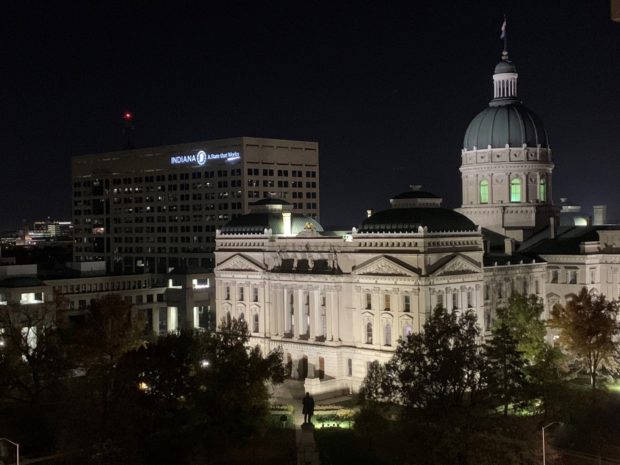This week, I’m attending my first in-person conference in more than three years. I am in Indianapolis at the annual Library Marketing and Communications Conference. This is my third time attending this event and what I loved about it most in 2016 is still true today. The attendees are a mix of librarians and non-librarian staff, instruction and outreach folks, graphic designers, social media managers, front-line staff and administrators, all from both academic and public libraries. It’s a hodgepodge of “people who do outreach work” with a specific focus on communications. These are people who do the same work I do, albeit in a wide variety of settings and capacities.
I attended every possible session on Day 1 of the two-day conference. Here’s a run-down of my favorite sessions.
Chris Tonelli (NC State) on “The Comfortable Uncomfortable”
Tonelli spoke about two recent events from the NC State Libraries system: the discovery of the First white supremacist history of their building’s namesake as well as the discovery of a library-adjacent (though not technically employee of) staff member who identified as a Proud Boy and was accused of doxxing students. Tonelli’s presentation urged folks in the room to not think of these as “PR nightmares” and instead see them as opportunities for healing, connection, and clearly communicating your institution’s values. I particularly appreciated how he walked us through the entire communications cycle between the library’s external relations team, library administration, and university communications. As he reiterated numerous times, having a good working relationship between all three entities is essential for finding a solution that is respectful of both the institution and the people who (rightfully) brought the issues to light.
Main takeaway: Never accept the first draft of an external comms. And if you don’t agree with it, offer an alternative draft.
Chris Vitellio and Charles Samuels (NC State) on “When Other People Try to Do Your Job”
As an outreach librarian, I would never unilaterally negotiate an e-resources contract with a vendor. I would never accept (on my own) the gift of an archival collection. I would never set up my own roving reference desk. Yet, quite often I find myself having to negotiate communications- and programming-related agreements that others have made on behalf of the library. As Vitellio and Samuels point out, that’s part of the job: sometimes we are freelancers, collaborators, service-providers or, yes, an afterthought. They instead showed strategies and examples for how you can get more colleagues on board with your workflows and processes, including templates, style guides, and web forms.
Main takeaway: Try to shift your role from “creator” to “editor” when you can’t control the entire process.
Best line: (referring to logos and branding) “We are not a food court. We’re Apple.”
Brianna Marshall and Julie Pitts (NKU Steely Library) on “Transforming Non-Library Users into Library Advocates”
The project described in this presentation blew me away with its creativity and outcomes. Marshall and Pitts, in collaboration with a library student advocacy group, created a social media campaign that blended storytelling, scavenger hunts, and exploration of library spaces in a truly innovative way. To highlight their makerspace, they created 3D prints of stegosaurus babies in the style of a statue that occupies their library’s main lobby. On Instagram, they then encouraged students to “Find my babies” using clues and photo hints. The winning team would win a study room for a whole day of their choice, plus a catered lunch for 3 additional friends (brilliant!). The level of engagement they got through Instagram was through the roof.
Main takeaway: Scavenger hunts on Instagram can work, with the right incentive, the right story, and the right real-time modifications.
Erin Rushing (Smithsonian Libraries and Archives) on “Collaborative Social Media Strategies”
This idea has been on my to-do list for years: cooperating with other institutions to mutually engage and boost each others’ content. Initiatives like #ArchivesHashtagParty and #MuseMeme are good examples of such projects. Followers love to watch institutional accounts interact with each other. Some great ideas that came out of this session include “swapping” accounts with another unit on campus; connecting with institutions that have similar names as yours (and may be frequently confused); and finding creative ways to highlight similar collections across institutions.
Main takeaway: Clear your schedule. If you host something like this, it’s going to take all day.
Final Thoughts
As I am fond of saying and my colleagues are tired of hearing, “I don’t need more ideas. I need resources to implement those ideas.” It’s true: there is no lack of good ideas coming from library outreach circles. As one presenter noted, we’re all extremely creative people and it’s likely what attracted us to these positions in the first place. Add to that the fact that we work with colleagues who are as equally scrappy as we are creative, and you will have no end of potential outreach projects. However, there are only so many hours in a day, weeks in a year, and people on my team. So I am torn when returning home from conferences such as these: what can I implement now? And what needs to sit on the hold shelf until I’ve finished my current to-be-realized projects list? Regardless of my answer to those questions, I’m leaving Day 1 inspired and energized.

[…] year ago: Notes from the 2022 Library Marketing and Communications Conference Day 1 and Day […]